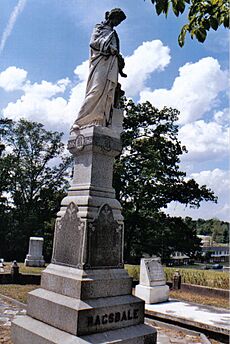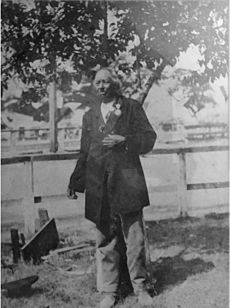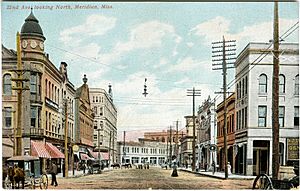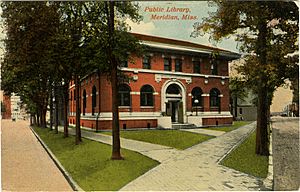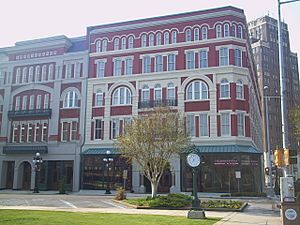History of Meridian, Mississippi facts for kids
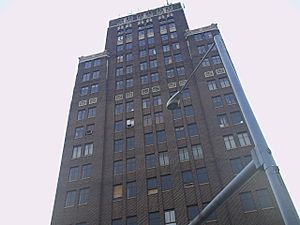
The history of Meridian, Mississippi began in the early 1800s, even before European-American settlers arrived. The land first belonged to the Choctaw Indians. The United States bought this land in 1830 through the Treaty of Dancing Rabbit Creek. Meridian grew up where two important train lines crossed: the Mobile and Ohio Railroad and the Southern Railway. Because of this, its economy was mostly based on trains.
Even though much of the city was burned during the Battle of Meridian in the American Civil War, it was rebuilt and entered a "Golden Age." From about 1890 to 1930, Meridian was the biggest city in Mississippi. It was also a top place for manufacturing in the Southern United States. When the railroading industry slowed down in the 1950s, the city's economy struggled, and its population slowly dropped. In recent years, Meridian has worked hard to bring new businesses and industries to the city, especially to its downtown area.
Contents
Meridian's Beginnings
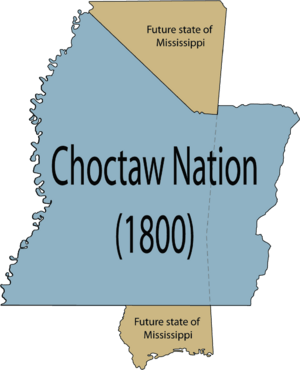
Under pressure from the U.S. government, the Choctaw Native Americans agreed to move from their lands east of the Mississippi River. This was part of the Treaty of Dancing Rabbit Creek in 1830. Many Choctaws moved to what is now Oklahoma. However, a good number chose to stay in their homeland. Today, most Choctaws in Mississippi are part of the Mississippi Band of Choctaw Indians. They live on special lands called Indian Reservations across the state. The biggest one is about 35 miles (56 km) northwest of Meridian.
After the treaty, European-American settlers quickly moved into the area. In 1831, a man from Virginia named Richard McLemore became the first settler of Meridian. He received a federal land grant of about 2,000 acres (809 hectares). McLemore owned most of the land and had the only big home nearby. To attract more people, he offered free land to newcomers. By 1833, enough people had moved there to create a county government. This led to the establishment of Lauderdale County.
In 1853, when the Mobile and Ohio Railroad began building tracks in the area, Lewis A. Ragsdale and John T. Ball bought most of Richard McLemore's land. Both men wanted to make money from where the Mobile and Ohio line would cross another planned railroad, the Vicksburg and Montgomery Railroad. Ragsdale bought the McLemore Farm, which included much of what would become downtown Meridian. Ball bought land west of Ragsdale's. McLemore and his family moved away, and Ragsdale turned McLemore's old log home into a tavern.
Ragsdale and Ball, now known as the city's founders, started competing. They both laid out lots for new buildings on their land. They also argued over the city's name. Ball liked "Meridian" because it meant "junction," like the train crossing. But the farmers in the area preferred "Sowashee," a Native American name for a nearby creek. Ragsdale wanted to name the town "Ragsdale City" after himself. Ball quickly built a small train station and convinced the Mobile and Ohio Railroad to make it a stop.
The competition between Ragsdale and Ball continued. Each day, the sign on the station would change between "Meridian" and "Sowashee." They even laid out city streets differently. One day, one would put down stakes for his street plan, and the next day, the other would pull them up and put down his own. Ball made his streets parallel to the railroad, while Ragsdale used true compass directions. You can still see this competition today in how some streets meet at odd angles in the city.
Eventually, more railroad workers moved in. They decided the name "Meridian" should stay on the station permanently. The town was officially named Meridian on February 10, 1860. The Vicksburg and Montgomery Railroad (later part of the Southern Railway) was planning to cross the Mobile and Ohio Railroad in another town. But Meridian's businessmen convinced Southern Railway to cross in Meridian instead. This made Meridian an even more important railroad hub.
Meridian During the Civil War
When the American Civil War started in 1861, Meridian was a small village. It had a few stores, hotels, and two churches. Because of its important location at the railroad crossing, the Confederate side built an arsenal (a place to store weapons), a military hospital, and a prison camp there.
On February 19, 1863, a train carrying Confederate soldiers and civilians left Meridian. It was heading to help in the coming Battle of Vicksburg. The train crashed near Chunky, Mississippi. The 1st Choctaw Battalion, a group of Native American soldiers, helped rescue people.
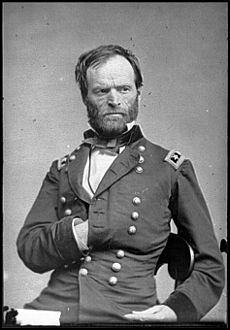
After the 1863 Vicksburg campaign, Union forces led by General William Tecumseh Sherman moved toward Meridian. Sherman used clever moves to trick the Confederate leader, Lieutenant General Leonidas Polk. Polk thought Sherman was going to Mobile, Alabama, so he moved his troops away from Meridian. This left Meridian open to the Union army.
Sherman reached Meridian on February 14, 1864. He waited for another Union general to join him. While waiting, Sherman ordered his troops to destroy the city. They ruined the railroads in every direction and burned many buildings, including an arsenal and large storehouses. Sherman reportedly said, "Meridian with its depots, store-houses, arsenal, hospitals, offices, hotels, and cantonments no longer exists." Despite this huge destruction, the railroad lines were quickly repaired and working again in just 26 days.
Rebuilding After the War
Soon after the Civil War, Meridian's downtown area grew, and its population increased. By 1870, the city had 2,709 people and became the county seat of Lauderdale County. This growth led to new schools and different churches. However, this progress was set back in 1871 when downtown was destroyed by a fire during the Meridian race riot. This event was linked to efforts by freed African Americans to stand up against the Ku Klux Klan, a group that caused a lot of trouble.
The city quickly recovered. In 1872, it made a rule that new buildings in the fire district had to be made of brick. The late 1870s were still tough for the city, with money problems and a yellow fever epidemic in 1878. Yellow fever affected almost 500 people and killed at least 86. This led to a quarantine where people entering the city needed a health certificate. Despite these early challenges, Meridian soon experienced a big economic boost and entered its "Golden Age."
Meridian's Golden Age
Growing as a Railroad Hub
Meridian grew a lot in the 1880s. It added electricity, running water, a sewage system, and paved streets. By 1885, it was the main railroad center in eastern Mississippi. This was because it was where five different railroad lines met. The railroads brought transportation and many new businesses, which made the population boom. The city's population nearly tripled from 2,709 in 1870 to about 8,000 by 1885. By 1906, it reached 28,000, and the city was called "The Queen City." Between 1890 and 1930, Meridian was the biggest city in Mississippi and a top center for manufacturing in the South.
As the city grew, a business area developed downtown. A mule-drawn trolley system helped people get around. This system later became an electric trolley system in 1897. The electric trolleys helped the city spread out and increased business downtown. They even reached up to 10 miles (16 km) north of downtown. A popular stop was Highland Park.
Industry profits helped build many of the city's major buildings. This included the Grand Opera House, which opened in 1890. Today, this opera house is part of "The Mississippi State University Riley Center for Education and Performing Arts." A key business from this time was Soulé Steam Feed Works, which helped the cotton and lumber industries grow in the city.
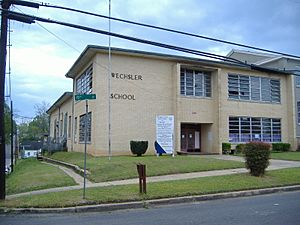
In 1894, the Wechsler School was built. This was the first brick public school building in Mississippi for African-American children. The community voted to build this important school. It served the city until 1978 and is now being renovated for community use.
Turn of the Century and New Buildings

With more people and train traffic, the city built Union Station in 1906 to manage all the railroads. Many hotels were also built for passengers and workers, like Hotel Meridian and Union Hotel. By 1907, about 40 trains passed through the city each day, and the railroad companies provided over 6,000 jobs. By 1920, as many as 100 trains passed through the station daily! The station was partly torn down later, but the city rebuilt it in 1996 to look like its original style. It is now called the Meridian Multi-Modal Transportation Center.
In 1908, a local club and city leaders worked to get a Carnegie library for Meridian. They also raised money for an African-American library. Two Carnegie libraries were built in 1913: one for white people and one for African Americans. The library for African Americans was the first and only one for black people in Mississippi until after World War I. It was also the only Carnegie library ever built just for African Americans in the country. The library for white people is now the Meridian Museum of Art.
World Wars and Economic Changes
In 1913, a new city government brought 90 industrial plants to Meridian. This attracted many new settlers, and the city's population kept growing into the 1920s. After World War I, a monument was put up to honor soldiers from the area who died in battle. In the 1920s, Meridian's car industry also grew. The old streetcar system was replaced by buses in 1925. Buses were better because they could cross the railroad tracks that divided the city.
In 1929, the Threefoot Building, Meridian's tallest skyscraper with seventeen stories, was built in the Art Deco style. Today, this historic building is an important city landmark.
Even during the Great Depression after the stock market crash of 1929, Meridian still attracted new businesses. People often went to theaters to watch movies and "escape" their troubles. The Grand Opera House became outdated and was replaced by the Temple Theater in 1928. This new theater was much bigger and still has one of only two Robert Morton pipe organs in Mississippi that are still in their original place.
The New Deal programs helped renovate some city buildings in the 1930s. Then, World War II brought a new economic boost. Railroads were crucial for transporting fuel and materials for military vehicles, making Meridian a railroad center again. This good time lasted until the 1950s. Then, cars and the Interstate Highway System became more popular than passenger trains. This led to many job losses in the railroad industry, and the city's population began to decline. Meridian has been working hard to create a new economy based on modern industries.
Civil Rights Movement
During the American Civil Rights Movement in the 1960s, Meridian was a key place for organizing and activism. The Congress of Racial Equality (CORE) had an office there. Members like James Chaney and other local people, along with volunteers from the North like Michael and Rita Schwerner and Andrew Goodman, worked to help people register to vote and create community centers.
The work of these activists was not always welcomed by everyone, especially some white residents. This caused a lot of tension and sometimes led to violence. In June 1964, Chaney, Schwerner, and Goodman went to Neshoba County, Mississippi, to meet with members of a black church that had been bombed. The three young men disappeared that night on their way back to Meridian.
Two months later, authorities found their bodies buried in an earthen dam. The federal government charged seventeen members of the Klansmen group. Seven men were found guilty of conspiracy. In 2005, the case was reopened, and one of the Klansmen, Edgar Ray Killen, was found guilty of three counts of manslaughter.
The murders of Chaney, Goodman, and Schwerner helped gain national support for new laws to end segregation and protect the voting rights of all citizens. Meridian later honored James Chaney by renaming part of 49th Avenue after him. The city also holds a memorial service each year and built a memorial at his gravesite. In 2014, Meridian created a Civil Rights Trail, a self-guided tour of eighteen important stops related to the movement.
Bringing Downtown Back to Life
After World War II, Meridian's downtown area started to decline as people moved to new neighborhoods. To protect the historic buildings, several areas were named historic districts in the 1970s and 80s. Meridian now has nine historic districts, all listed on the National Register of Historic Places.
In 1997, efforts helped build a new Amtrak Station. It was designed like the historic train station from Meridian's Golden Age. This new station sparked a citywide effort to bring downtown back to its lively past.
Many old buildings have been renovated. The Rosenbaum Building was reopened in 2001 with apartments and shops. Weidmann's restaurant, built around 1870, was renovated and reopened in 2002. The historic Grand Opera House was renovated in 2006 into the "Mississippi State University Riley Center for Education and the Performing Arts." A new parking garage was also built for the Riley Center.
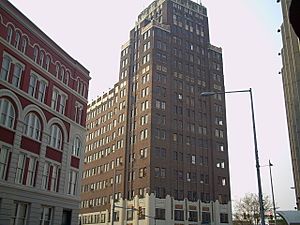
Today, the effort to revitalize downtown is led by three private groups: the Alliance for Downtown Meridian, Meridian Main Street, and the Meridian Downtown Association. They work together to promote new development and restoration. The Alliance helps businesses like specialty shops, restaurants, and bars to make downtown more active day and night. The Meridian Downtown Association organizes special events to bring more people downtown, and Meridian Main Street supports existing businesses.
There are also plans for new museums downtown and an African-American Business District. Several murals and public art projects are planned for buildings.
Historic Hotels
 |
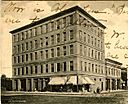 |
| Great Southern Hotel (1890) | Hotel Meridian (1907) |
 |
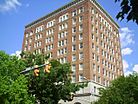 |
| Union Hotel (1908) | Lamar Hotel (1927) |
Meridian has had many historic hotels throughout its history. When the railroads grew and the original Union Station was built in 1906, many hotels were constructed for train passengers and workers. These included the Elmira Hotel (1905), Terminal Hotel (1910), Hotel Meridian (1907), and Union Hotel (1908).
As the city grew, so did its hotels. The eleven-story skyscraper Lamar Hotel was built in 1927. Today, the Lamar Hotel is a county office building and is listed on the National Register of Historic Places.
Another important historic hotel was the E.F. Young Hotel, built in 1931. It was in the African American business district and was one of the only places where traveling African Americans could find a room during segregation.
Most hotels moved out of downtown in the 1960s and 70s. But now, there's a push for a new downtown hotel, especially after the Riley Center was renovated in 2006. The Threefoot Building is a main focus for these efforts to bring a hotel back downtown.
Historic Districts
Meridian has nine historic districts listed on the National Register of Historic Places. These districts show the city's rich history through their buildings. Many different architectural styles from the late 1800s and early 1900s can be seen, such as Queen Anne, Colonial Revival, Italianate, Art Deco, and Bungalow. The districts are:
- 1 East End Historic District
- 2 Highlands Historic District
- 3 Meridian Downtown Historic District
- 4 Meridian Urban Center Historic District
- 5 Union Station Historic District
- 6 Merrehope Historic District
- 7 Mid-Town Historic District
- 8 Poplar Springs Road Historic District
- 9 West End Historic District
Images for kids


